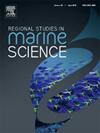墨西哥太平洋沿岸和远洋鲨鱼中Lorenzini壶腹的分布和形态
IF 2.4
4区 环境科学与生态学
Q3 ECOLOGY
引用次数: 0
摘要
板鳃的电感觉系统是由称为洛伦兹尼壶腹的特殊结构组成的,它位于头部的前部。这些器官能探测到弱电场。电感受器分布在头侧皮肤的背侧和腹侧,在猎物探测中起着核心作用。它们的形态、分布和密度主要由系统发育决定,并与物种的生态密切相关。本研究分析了墨西哥太平洋南下加利福尼亚海岸4种鲨鱼中Lorenzini壶腹的丰度、空间分布和组织学特征。平均孔数最高的是棘球藻(Sphyrna zygaena)(1938 ± 41.5),其次是白鼠(Mustelus henlei)(863 ± 22.15)、青光眼(Prionace glauca)(790 ± 16.8)和灰熊(Isurus oxyrinchus)(438 ± 25.1)。壶腹在不同种间形态各异,没有细胞分化的迹象。海洋种(P. glauca和I. oxyrinchus)气孔较少,壶腹较大,而沿海种(S. zygaena和M. henlei)气孔较少。本研究通过揭示不同觅食策略的鲨鱼壶腹分布和形态的变化,提高了对电感觉系统的认识。本文章由计算机程序翻译,如有差异,请以英文原文为准。
Distribution and morphology of the ampullae of Lorenzini in coastal and pelagic sharks from the Mexican Pacific
The electrosensory system in elasmobranchs is composed of specialized structures called the ampullae of Lorenzini, located in the anterior region of the head. These organs can detect weak electric fields. The electroreceptors are distributed in the dorsal and ventral cephalic skin and play a central role in prey detection. Their morphology, distribution, and density are primarily determined by phylogeny and are closely related to the species’ ecology. In the present study, we analyzed the abundance, spatial distribution, and histological features of the ampullae of Lorenzini in four shark species from in four shark species off the coast of Baja California Sur, Mexican Pacific. Sphyrna zygaena, exhibited the highest mean pore count (1938 ± 41.5), followed by Mustelus henlei (863 ± 22.15), Prionace glauca (790 ± 16.8), and Isurus oxyrinchus (438 ± 25.1). The ampullae exhibited variable morphology among species, with no evidence of cellular differentiation. Oceanic species (P. glauca and I. oxyrinchus) had fewer pores but larger ampullae compared with coastal species (S. zygaena and M. henlei). This study improves the knowledge of the electrosensory system by revealing variation in the distribution and morphology of these ampullae in sharks with different foraging strategies.
求助全文
通过发布文献求助,成功后即可免费获取论文全文。
去求助
来源期刊

Regional Studies in Marine Science
Agricultural and Biological Sciences-Ecology, Evolution, Behavior and Systematics
CiteScore
3.90
自引率
4.80%
发文量
336
审稿时长
69 days
期刊介绍:
REGIONAL STUDIES IN MARINE SCIENCE will publish scientifically sound papers on regional aspects of maritime and marine resources in estuaries, coastal zones, continental shelf, the seas and oceans.
 求助内容:
求助内容: 应助结果提醒方式:
应助结果提醒方式:


